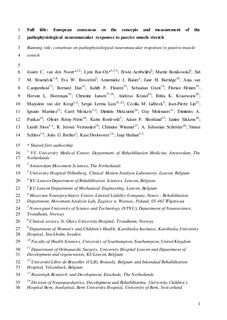| dc.contributor.author | van den Noort, Josien C. | |
| dc.contributor.author | Bar-On, Lynn | |
| dc.contributor.author | Aertbeliën, Erwin | |
| dc.contributor.author | Bonikowski, Marcin | |
| dc.contributor.author | Brændvik, Siri Merete | |
| dc.contributor.author | Broström, Eva Weidenhielm | |
| dc.contributor.author | Buizer, Annemieke I. | |
| dc.contributor.author | Burridge, Jane Helena | |
| dc.contributor.author | van Campenhout, Anja | |
| dc.contributor.author | Dan, Bernard | |
| dc.contributor.author | Fleuren, Judith F.M. | |
| dc.contributor.author | Grunt, Sebastian | |
| dc.contributor.author | Heinen, Florian | |
| dc.contributor.author | Horemans, Herwin L.D. | |
| dc.contributor.author | Jansen, C. | |
| dc.contributor.author | Kranzl, Andreas | |
| dc.contributor.author | Krautwurst, Britta K. | |
| dc.contributor.author | van der Krogt, Marjolein Margaretha | |
| dc.contributor.author | Lerma Lara, Sergio | |
| dc.contributor.author | Lidbeck, Cecilia M. | |
| dc.contributor.author | Lin, Jean-Pierre | |
| dc.contributor.author | Martinez, Ivette | |
| dc.contributor.author | Meskers, Carel G. | |
| dc.contributor.author | Metaxiotis, Dimitrios | |
| dc.contributor.author | Molenaers, Guy | |
| dc.contributor.author | Patikas, Dimitrios A. | |
| dc.contributor.author | Rémy-Néris, Olivier | |
| dc.contributor.author | Roeleveld, Karin | |
| dc.contributor.author | Shortland, Adam Peter | |
| dc.contributor.author | Sikkens, Jonne J. | |
| dc.contributor.author | Sloot, Lizeth | |
| dc.contributor.author | Vermeulen, R. Jeroen | |
| dc.contributor.author | Wimmer, Cornelius | |
| dc.contributor.author | Schröder, Alexandra Sebastian | |
| dc.contributor.author | Schless, Simon Henri | |
| dc.contributor.author | Becher, Jules Guilhelmus | |
| dc.contributor.author | Desloovere, Kaat | |
| dc.contributor.author | Harlaar, Jaap | |
| dc.date.accessioned | 2017-12-19T15:11:13Z | |
| dc.date.available | 2017-12-19T15:11:13Z | |
| dc.date.created | 2017-10-03T13:33:53Z | |
| dc.date.issued | 2017 | |
| dc.identifier.citation | European Journal of Neurology. 2017, 24 (7), 981-e38. | nb_NO |
| dc.identifier.issn | 1351-5101 | |
| dc.identifier.uri | http://hdl.handle.net/11250/2473073 | |
| dc.description.abstract | Background and purpose
To support clinical decision-making in central neurological disorders, a physical examination is used to assess responses to passive muscle stretch. However, what exactly is being assessed is expressed and interpreted in different ways. A clear diagnostic framework is lacking. Therefore, the aim was to arrive at unambiguous terminology about the concepts and measurement around pathophysiological neuromuscular response to passive muscle stretch.
Methods
During two consensus meetings, 37 experts from 12 European countries filled online questionnaires based on a Delphi approach, followed by plenary discussion after rounds. Consensus was reached for agreement ≥75%.
Results
The term hyper-resistance should be used to describe the phenomenon of impaired neuromuscular response during passive stretch, instead of for example ‘spasticity’ or ‘hypertonia’. From there, it is essential to distinguish non-neural (tissue-related) from neural (central nervous system related) contributions to hyper-resistance. Tissue contributions are elasticity, viscosity and muscle shortening. Neural contributions are velocity dependent stretch hyperreflexia and non-velocity dependent involuntary background activation. The term ‘spasticity’ should only be used next to stretch hyperreflexia, and ‘stiffness’ next to passive tissue contributions. When joint angle, moment and electromyography are recorded, components of hyper-resistance within the framework can be quantitatively assessed.
Conclusions
A conceptual framework of pathophysiological responses to passive muscle stretch is defined. This framework can be used in clinical assessment of hyper-resistance and will improve communication between clinicians. Components within the framework are defined by objective parameters from instrumented assessment. These parameters need experimental validation in order to develop treatment algorithms based on the aetiology of the clinical phenomena. | nb_NO |
| dc.language.iso | eng | nb_NO |
| dc.publisher | Wiley | nb_NO |
| dc.title | European consensus on the concepts and measurement of the pathophysiological neuromuscular responses to passive muscle stretch | nb_NO |
| dc.type | Journal article | nb_NO |
| dc.description.version | submittedVersion | nb_NO |
| dc.source.pagenumber | 981-e38 | nb_NO |
| dc.source.volume | 24 | nb_NO |
| dc.source.journal | European Journal of Neurology | nb_NO |
| dc.source.issue | 7 | nb_NO |
| dc.identifier.doi | 10.1111/ene.13322 | |
| dc.identifier.cristin | 1501838 | |
| dc.description.localcode | This is the pre-peer reviewed version of the following article: [European consensus on the concepts and measurement of the pathophysiological neuromuscular responses to passive muscle stretch], which has been published in final form at [http://onlinelibrary.wiley.com/doi/10.1111/ene.13322/abstract]. This article may be used for non-commercial purposes in accordance with Wiley Terms and Conditions for Self-Archiving. | nb_NO |
| cristin.unitcode | 194,65,30,0 | |
| cristin.unitname | Institutt for nevromedisin og bevegelsesvitenskap | |
| cristin.ispublished | true | |
| cristin.fulltext | preprint | |
| cristin.qualitycode | 2 | |
